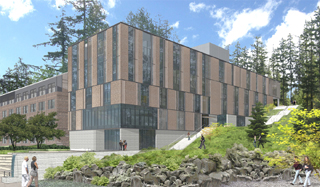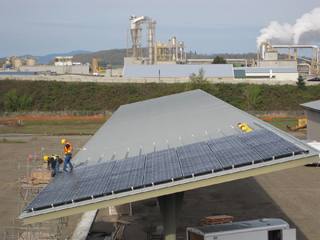|
Subscribe / Renew |
|
|
Contact Us |
|
| ► Subscribe to our Free Weekly Newsletter | |
| home | Welcome, sign in or click here to subscribe. | login |
Environment
| |
 |
February 28, 2013
Don’t let green-minded clients leave you behind
Lease Crutcher Lewis

Sorensen
|
Today, every major contractor “does” sustainability. After at least 20 years of industry transformation, we’ve all built LEED projects, and we all have green stories to tell.
Now there are new questions: Are your firm’s services fully aligned with what clients value and their specific goals? Do your internal practices support your culture and bring true environmental benefit?
Client focus
Five or 10 years ago, the contractor’s role was simple. For a sustainably focused project we’d analyze efficient design options, recycle and keep up with paperwork, ending up with LEED silver or gold on a straightforward building.
Today, many clients have far more aggressive goals, whether using LEED, the Living Building Challenge (related to net zero), the 2030 Challenge (carbon neutrality), or others. There is much greater emphasis on actual building performance.
One challenge is that sustainability can mean hugely different things to different clients, so understanding the specific priorities is a starting point, whether related to a rating system or not.
Does it mean on-site power generation, rainwater collection, or ground-source heating and cooling? Daylighting? Envelope performance? Saving much of an existing building? Sourcing materials within 500 miles? Clean indoor air? On-site waste treatment? Certified forestry methods? And how do these priorities relate to price variables (if any), schedule, and occupant comfort? Are the client’s motives primarily business or altruistic?
Contractors need to think through all of the relevant elements in great detail, integrating into the process rather than just checking boxes on a list, with detailed analysis of system concepts and subcontractor and material buyout options, aided by strong local relationships.
What’s ahead
Many green practices that were considered aggressive are becoming mainstream as tenant expectations rise, systems prove themselves and codes change. Perhaps most notably, the city of Seattle is committed to carbon neutrality by 2050, with a major aspect being more efficient buildings with more on-site energy sources.
This will be accomplished via incremental yet dramatic code changes affecting new buildings as well as upgrades to existing buildings. In December, the city’s Green Ribbon Commission recommended an action plan, which is now in review phase and will soon filter down to become specific building codes.
Carbon neutrality will require new technologies, as we can get only partway there with current systems. With any new or experimental system, there is risk that a good theory and design will have unintended outcomes due to how it is installed, used and maintained, and how it interacts with other systems. Therefore, contractors and end users need to be involved from the start, working alongside the manufacturers and building designers to ensure that the new performance-based codes will be met upon completion and successful over the building’s lifetime.
Contractors must also understand the whys and hows of all systems so we can help the entire team analyze how systems interact, then coordinate the detailing for subcontractor buyout and shop drawings and ensure that they’re built correctly.
Along with end users, we need to incorporate details such as maintenance access and how systems will actually be used. Further, as future requirements are focusing more on building performance rather than prescriptive standards (such as actual energy use rather than insulation value), we need to help use empirical data to understand outcomes and keep improving.
Walking your talk
We contractors must look at internal operations set a standard of sustainability. Lean practices are essential for this.
For example, reducing paper is a worthy goal. However, in our experience real advances start by thinking about lean delivery comprehensively, such as how communication and collaboration can be improved. If the goal is to share design updates in real time, online solutions (from BIM outputs to simple tools such as Bluebeam) are better from that perspective, while also avoiding a lot of printing and transporting.
From there, a culture of waste reduction can make great additional strides, with an ethic of sharing, double-siding, and not printing file copies whenever possible. As a byproduct of improved delivery methods, we have reduced paper use by 75 percent.
Transportation is a huge factor. Just as locally sourcing wood products might cut hundreds of truck miles, locating your office near transit and bike routes can help cut hundreds of car miles of driving every day.
While a car can be useful for visiting remote job sites, I personally find the occasional Zipcar to be plenty, and the bus is added time for catching up with email.
Proximity to clients and collaborators is also helpful. Even with online tools it will always be important to meet in person. Being able to walk to many of the construction clients and design firms in town is a key reason many contractors locate in or near downtown Seattle.
We know where the industry is going. Every contractor has the opportunity to stay ahead of the curve by focusing on sustainability at every level and focusing on what each client values.
Jay Sorensen is vice president and Special Projects Division manager at Lease Crutcher Lewis.
Other Stories:
- New transfer station lifts Makahs out of the dumps
- Engineering school’s new home reflects its values
- Falling costs could mean a bright future for solar panels
- Is LEED’s future with federal projects under threat?
- A crucial step that green building teams often skip
- Thermal ‘ravioli’ keeps building temps in check
- Bullitt neighbor seeks a green distinction of its own
- How contractors can make the supply chain greener
- What to look for in a green building




